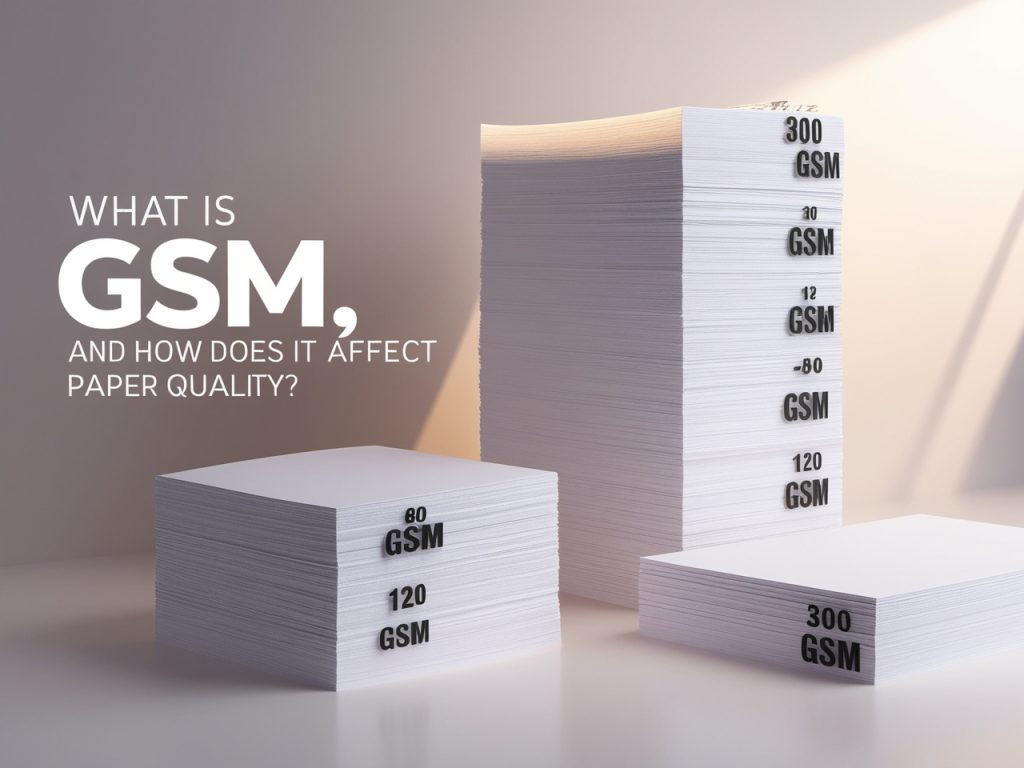
GSM stands for Grams per Square Meter, and it is a standard measurement used to indicate the weight and thickness of paper. Essentially, it tells you how much a single sheet of paper would weigh if it measured one square meter. The higher the GSM number, the heavier and thicker the paper will be. Understanding GSM is crucial when selecting the right paper for your project, as it directly affects the quality, durability, and feel of the final printed product.
Understanding GSM and Paper Weight #
GSM is an important factor in determining the strength and durability of paper. For example, lightweight paper (low GSM) is often more flexible and used for everyday printing, while heavier paper (high GSM) is thicker and used for premium products like business cards and brochures.
Below is a general guide to common GSM ranges and their typical uses:
1. Lightweight Paper (70-120 GSM) #
- 70-90 GSM: This is the standard weight for copy paper used in everyday office printers and home printing. It’s light, easy to handle, and ideal for printing simple documents like letters or reports.
- 100-120 GSM: Slightly thicker than copy paper, this range is commonly used for posters, flyers, and brochures that need a bit more durability but are still easy to fold or handle.
Best For: Office paper, flyers, letterheads, and everyday printing.
Pros:
- Lightweight and flexible.
- Inexpensive and widely available.
- Easy to fold and handle for large quantities.
Cons:
- Lacks durability and may not leave a lasting impression.
- Not suitable for high-end printing where thicker paper is preferred.
2. Medium Weight Paper (130-170 GSM) #
- 130-170 GSM: This is a good mid-range paper weight that’s often used for high-quality posters, brochures, and catalog pages. It provides a noticeable thickness without being too bulky or difficult to handle.
Best For: Flyers, brochures, posters, and magazine pages.
Pros:
- Sturdier and more durable than lightweight paper.
- Provides a good balance between flexibility and quality.
- Can handle more color and design elements without bleeding through.
Cons:
- Still relatively thin and may not have the same premium feel as heavier papers.
3. Heavyweight Paper (200-300 GSM) #
- 200-300 GSM: This range is often used for premium print products like high-end flyers, postcards, and professional marketing materials. Paper in this range feels thick and substantial, making it ideal for projects where presentation and quality matter.
Best For: Postcards, high-end brochures, invitations, and premium marketing materials.
Pros:
- Thick and durable, giving the print materials a premium feel.
- Holds color well, making it ideal for designs with vibrant colors and detailed artwork.
- Ideal for double-sided printing due to its opacity.
Cons:
- More expensive than lighter paper.
- May be harder to fold without scoring.
4. Cardstock and Board (350+ GSM) #
- 350+ GSM: Paper in this range is usually referred to as cardstock or board, and it is much thicker than regular paper. This is often used for business cards, packaging, and other materials where durability is essential. This weight provides a strong, rigid feel and a professional appearance.
Best For: Business cards, greeting cards, packaging, and book covers.
Pros:
- Extremely sturdy and durable.
- Perfect for products that need to leave a lasting impression.
- Offers a premium feel that enhances the tactile experience.
Cons:
- More expensive than lighter paper types.
- Too thick for standard printing jobs and not suitable for folding without creasing.
How GSM Affects Paper Quality #
1. Durability: #
- Higher GSM means thicker and more durable paper. For example, 350 GSM paper is much more resilient than 100 GSM paper. Heavier paper types are less prone to creasing, tearing, or wrinkling, making them ideal for products that need to be handled frequently, such as business cards or brochures.
- Lower GSM paper is more flexible and lightweight, making it suitable for everyday use like office printing or flyers. However, it may not stand up well to heavy handling.
2. Perceived Quality: #
- The heavier the GSM, the more luxurious and professional the printed product feels. For example, business cards printed on 350 GSM cardstock will feel substantial and durable, leaving a better impression than those printed on thinner paper.
- Lower GSM paper may feel flimsy, which can reduce the perceived value of the product.
3. Print Quality: #
- Heavier paper (higher GSM) typically offers better print quality, as it can absorb more ink without warping or bleeding. This results in sharper images, vibrant colors, and a professional appearance.
- Lighter paper may show bleed-through when printing with heavy ink coverage or double-sided designs, which can affect the overall quality of the final product.
4. Handling: #
- Lighter GSM paper is easier to fold, making it ideal for projects like brochures and pamphlets where folding is required. However, heavier paper requires scoring or special folding techniques to prevent cracking along the fold.
- Heavier GSM paper provides rigidity, which is perfect for products that need to hold their shape, like invitations or menus.
Choosing the Right GSM for Your Project #
When selecting the GSM for your print project, consider the following factors:
- Purpose: What is the goal of your project? For premium products like business cards, high-end brochures, or invitations, higher GSM (200-350+) offers a luxurious feel. For everyday printing, flyers, or handouts, lower GSM (70-120) may be sufficient.
- Durability: If your print materials will be handled frequently, such as brochures or packaging, opt for heavier paper to ensure durability.
- Cost: Heavier paper typically costs more, so factor this into your budget. If your project is cost-sensitive, lighter GSM paper may be more economical while still achieving good results.
- Visual Impact: For projects that rely heavily on visuals, such as posters or photo prints, thicker paper can enhance color vibrancy and detail, resulting in a more polished, professional look.
Conclusion #
GSM is a critical factor in determining the quality, durability, and overall feel of your printed materials. By understanding how different GSM values affect your project, you can choose the right paper weight to ensure your materials meet your expectations, whether you’re printing business cards, brochures, invitations, or flyers.
You can find free business card templates on Freepik.
Learn more about the different printing methods in this comprehensive guide.





